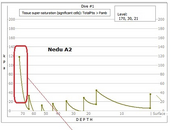Honestly, I have a statistical concern with the NEDU study and I could complain about that. BUT...if we look at the actual proportion of hits, the numbers do suggest that we should be thinking critically about the gospel of deep stops.
A very reasonable statement. We HAVE to think critically about that 'gospel', and we HAVE to think critically about how to assess the validity of that 'gospeI', in no small part because the NEDU study was not designed to,
nor could possibly, evaluate the validity of that 'gospel'. Personally, I understand the basis for the use of a one-sided test, given the stated hypothesis, although I could be persuaded that a more robust analysis would have involved a two-sided test. The trial starts with the hypothesis that was is / was currently being done was the gold standard. And, to make a decision to change to an alternative approach requires demonstration of superiority of that alternative.
RyanT:
I'd like to see a stronger empirical data set, but how often can you find folks lining up to get bent?
I think there would be general agreement with any desire to have a stronger dataset, for any trial. BUT, the NEDU study actually provides a pretty strong empirical dataset, probably as good as we are going to get with regard to the area of research focus. This was a d*** good study in many ways - the hypothesis was clearly stated, the rationale for the trial methodology was clearly stated, the methods employed were clearly stated, the results were clearly summarized, and the ONE, SINGULAR conclusion that the authors drew from the study - 'deep stop air decompression schedules are more efficient than shallow stop schedules' - was also clearly stated. Note that the conclusion did not explicitly state that deep stops were safer or more dangerous. They did not say that bubble model or gas content models were 'better' or 'worse'. The result are useful
in the context of the hypothesis that was tested - deep stop air decompression schedules are more efficient than shallow stop schedules -
and in the manner in which that hypothesis was tested. The study was actually about
efficiency - and the two decompression schedules were designed around that premise.
RyanT:
Also, Ross keeps complaining that the NEDU study didn't test deep stops and therefore isn't relevant.
I am not sure he said it is not
relevant. What he has been consistently arguing - as I understand his comments - is that the NEDU study did not test 'deep stops' that are consistent with contemporary technical diving practices. For example, I originally was taught that a 'deep stop' was made at a depth that was equidistant between the maximum depth of the dive, and the first planned deco stop. If I was using a 50% mix on my dive as the first deco gas (to which I would switch at 70 feet), and my bottom depth was 170 feet, then my 'deep stop' would be 120 feet. That is considerably deeper than the 70 ft maximum first stop depth evaluated in the NEDU trial. That isn't a criticism of the study, merely a statement of the parameters.
RyanT:
I'm going to just hazard a guess here, but it seems that if the "deep stop" study treatment had started their stops even deeper, then we would have seen even more hits due to additional slow-tissue on-gassing.
I suspect that is EXACTLY the hazarded 'guess' - an extrapolation of results not substantiated by the trial design - that Ross is particularly concerned about. I don't know what would happen if the "'deep stop' study treatment had started their deep stops even deeper". I could certainly speculate, but that speculation has no relation to any objective assessment performed in the NEDU trial. The NEDU study results CANNOT possibly address that issue, NOT because the study was somehow flawed, but because it
wasn't designed to test that scenario. It is simply not 'fair' to the results of the trial to extrapolate and apply them to situations not assessed in the trial itself.
Unfortunately, some of the rhetoric in this thread, indeed the tone of the expression of some of the concerns, has compromised the opportunity for discussion of the science and applicability of the results. And, that is disappointing, because the study results merit serious consideration, as does the potential scope of applicability of those results.






